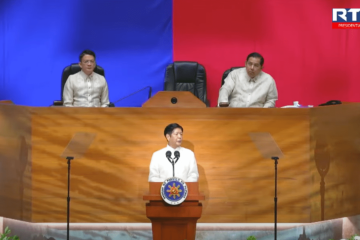
FILIPINOS HAVE a “sole duty to prevent the loss of a huge maritime space” by objecting China’s claim to the West Philippine Sea, Supreme Court Associate Justice Antonio Carpio told Thomasians in the 48th St. Thomas More lecture.
Carpio said the Philippines may lose 531,000 sq. km. of its maritime area, which is larger than the country’s 300,000 sq. km. land area if China wins the arbitration case.
“This is the heart of the matter of the dispute. Freedom of navigation is just incidental to me because this is a battle for resources over our Exclusive Economic Zone (EEZ) and Extended Continental Shelf (ECS),” he said.
Carpio, one of the country’s delegates to the Hague-based arbitral tribunal, perceived these activities as a demonstration of China’s “grand strategy to seize the South China Sea.”
“The grand design of China is very obvious. China wants to control the South China Sea for economic and military purposes,” he added.
In a position paper sent to the Tribunal, China maintained that it will neither accept nor participate in the arbitration because it believes the Tribunal has no jurisdiction over the matter, even though China stated otherwise in the 2002 ASEAN-China Declaration of Conduct.
China mainly insists on its historic rights, claiming it has owned the South China Sea 2, 000 years back, despite its participation in the ratification of the United Nations Convention on the Law of the Sea to eliminate historic rights as a valid basis of territorial claim.
The delegates figured that China’s Compilation of Historical Archives in the Southern Territories of the Republic of China published in July 2015 did not contain a single document justifying the nine-dash line claim of the South China Sea until the 20th century.
Carpio said that “all historic claims are extinguished because if you still claim beyond 200 nautical miles, there’s no point in having the law of the sea; there would still be a dispute.”
The Philippine delegate believes they have strong arguments and evidence that favored the Philippines in the initial ruling as China’s official and unofficial maps, dating from 1136 to 1912, proved its southernmost territory Hainan never reached the nine-dash line areas which overlap with other countries’ continental shelves.
Meanwhile, the Southeast Asia map and Philippine maps from 1636 to 1933 show that Scarborough and Spratlys have always been part of the Philippines.
“We have to have a credible self-defense, because in the history of the world, a country that did not have a credible self-defense eventually [was] erased from the map, the [giant] neighbor would swallow that country,” Carpio said.
He also asserted that it is “a battle to convince the Chinese people” to change their mindset that China owns the South China Sea because only then will their government comply with the ruling.
In its Note Verbale in 2009, China has entitled itself to 85.7 percent of the entire South China Sea through a nine-dash line claim, which gobbles up 25 percent of the high seas and large areas of the EEZ and ECS of Philippines, Brunei, Malaysia, Indonesia, and Vietnam.
China has seized, exploited, and established artificial islands and military presence in a number of reefs and shoals of its neighboring countries. Among these are the Philippines’ Subi Reef, Mischief Reef, Spratly Islands, and Scarborough Shoal. F ALEXANDRA J. AVILA and NAOMI GABRIELLE J. LORETO



